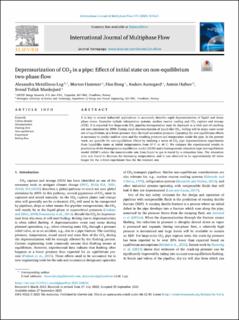Depressurization of CO2 in a pipe: Effect of initial state on non-equilibrium two-phase flow
Log, Alexandra Metallinou; Hammer, Morten; Deng, Han; Austegard, Anders; Hafner, Armin; Munkejord, Svend Tollak
Peer reviewed, Journal article
Published version
Permanent lenke
https://hdl.handle.net/11250/3103647Utgivelsesdato
2023Metadata
Vis full innførselSamlinger
- Publikasjoner fra CRIStin - SINTEF Energi [1614]
- SINTEF Energi [1731]
Originalversjon
10.1016/j.ijmultiphaseflow.2023.104624Sammendrag
It is key in several industrial applications to accurately describe rapid depressurization of liquid and dense phase states. Examples include refrigeration systems, nuclear reactor cooling and capture and storage (CCS). It is expected that large-scale pipeline transportation must be deployed as a vital part of reaching net zero emissions by 2050. During rapid depressurization of liquid-like , boiling will in many cases occur out of equilibrium, at a lower pressure than the local saturation pressure. Capturing the non-equilibrium effects is necessary to predict outflow rates and the resulting pressure and temperature inside the pipe. In the present work, we quantify the non-equilibrium effects by studying a series of pipe depressurization experiments from liquid-like states at initial temperatures from 10 °C to 40 °C. We compare the experimental results to predictions of the homogeneous equilibrium model (HEM) and a homogeneous relaxation-type non-equilibrium model (HRM*) where the mass-transfer rate from liquid to gas is tuned by a relaxation time. The relaxation time was found to decrease for increasing temperatures, and it was observed to be approximately 60 times longer for the coldest experiment than for the warmest one.

